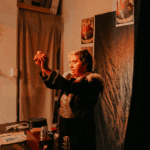
We often hear about animals going extinct, but languages? That’s a little harder to imagine. And yet, out of the 7,159 languages spoken around the world today, nearly half — 3,193 of them — are considered endangered.
Several are making the list of the most endangered languages in the world.
But what makes a language endangered? Is it simply the number of people who speak it? Or is it about how often it’s used in daily life, whether it’s taught to children, or how well it’s documented?
The answer is: all of the above — and more.
According to the United Nations Educational, Scientific and Cultural Organisation (UNESCO), a language becomes endangered when its use declines across generations, public life, and education, and when fewer people speak, teach, or even record it.
From how governments treat a language to how communities value their mother tongue, several factors contribute to a language’s survival — or its death.
But why does it matter? Why should we care if a language dies out?

A member of Hamere Berhan initiative writes scriptures in Ge’ez language on parchment made of goat skin in Addis Ababa, Ethiopia. Source: AFP
What happens when a language dies?
When a language dies, words and grammar disappear. And when that happens, an entire worldview vanishes when the last living member who speaks it passes away.
And with that all the stories, songs, jokes, ceremonies, and ways of thinking that shape a culture.
Language carries the collective memory of people, reflecting how they interact, understand, and relate to one another.
To lose a language is to lose a culture’s soul, its wisdom, and its connection to the past.
That’s not all. We may be losing some of the best local resources to save the planet.
Nancy Rivenburgh, a communications scholar, wrote for the International Association of Conference Interpreters explaining that today’s language loss is unlike anything seen before.
While languages have historically disappeared and emerged in a relatively balanced way — what linguists refer to as “linguistic equilibrium” — that balance has been disrupted over the past 500 years.
Now, dominant or so-called “metropolitan” languages are spreading rapidly, often overpowering smaller, indigenous ones.
What’s alarming is that these endangered languages are vanishing, without being replaced or revived.
Take the Great Andamanese language of Bo, once spoken in the Andaman Islands of India, as an example.
When Boa Senior, the last fluent speaker of Bo, died in 2010, the language died with her.
Even during her life, she walked a lonely road. She had no one to converse with in her mother tongue.
Along with Bo, unique knowledge about the Andamanese way of life, including traditional healing methods, oral histories, and environmental expertise that has been passed down over thousands of years, has disappeared.
It’s a haunting reminder that when a language fades, so does the identity and culture of an entire community.
A close goodbye: 10 most endangered languages in the world
1. North Frisian
Estimated speakers: 8,000
North Frisian is an indigenous language of West Germany and is officially listed by UNESCO as one of the most endangered languages in the world.
A member of the Indo-European language family, it is spoken along the coastlines and islands in the far northwest of Germany. The language is divided into two main groups: Island and Mainland North Frisian.
About 150 years ago, there were roughly 30,000 North Frisian speakers. By 2022, that number had dropped to around 8,000 native speakers across its many dialects, including Fering, Halligen Frisian, Karrharder, Nordergoesharder, and Öömrang.
Many blame the decline for schools not teaching it and limiting its use as a first language mainly among older adults.
2. Manchu
Estimated speakers: 100
Manchu was once the official language of the Qing Dynasty (1644–1911), spoken by millions for over 267 years. Over time, however, Mandarin Chinese was designated the official language of China and is now spoken by more than 955 million people.
Although the Manchu are China’s third-largest ethnic group, their language has experienced rapid decline. It is now listed among the world’s most endangered languages, with fewer than 100 speakers, most of them elderly.
One reason for its decline is its impracticality in modern life. Manchu uses its own script, adapted from the Mongolian writing system, and many young Manchu see little value in learning it today.

Provençal is also spoken in parts of Drôme, Gard, the Occitan Valleys of Italy and Switzerland, and the Val d’Aran in Catalonia, Spain. Source: AFP
3. Provençal
Estimated speakers: 140,000
Native to the Provence region in southeastern France, Provençal is a dialect of the Occitan language, a member of the Romance language family.
Despite its once widespread presence, it is now officially listed as one of the world’s most endangered languages.
One major reason for its decline is the limited body of literature, combined with the historical and continued dominance of French in education, government, and social life.
Today, there are fewer than 140,000 speakers, most of whom are middle-aged or elderly.
4. Ainu (Hokkaido, Japan)
Estimated speakers: 300
Ainu, the language of the indigenous Ainu people of Japan, is among the most endangered languages in the world — critically so.
Spoken for thousands of years, Ainu is considered a language isolate, meaning it has no known relation to any other language. This makes it uniquely valuable, but also harder to revitalise, as there are no linguistic parallels to draw from.
Political pressure from Japan’s central government is the main reason for its decline. During colonisation in the 1870s, about 15,000 people still spoke Ainu.
While exact figures today are unclear, a 2006 UNESCO poll found that out of 23,782 Ainu, only 304 knew the language, and just 4.6% of them felt fluent enough to teach it.
5. Kari’ña
Estimated speakers: 8,558
The Kari’ña language, also known as Carib or Kalina, is a Cariban language spoken by the Kalina people across several parts of South America, including Venezuela, Trinidad and Tobago, Brazil, Suriname, and French Guiana.
Traditionally an oral language, Kari’ña has long been used to pass down history, customs, and ancestral knowledge through storytelling and spoken word.
While efforts have been made to develop a written form, the language currently has multiple orthographies.
This lack of a standardised writing system poses challenges for formal education, documentation, and preservation.
Despite its presence in several countries, the language remains vulnerable. As of 2023, there are approximately 8,558 speakers, most of whom are elderly.
Without more substantial efforts in intergenerational transmission, literacy development, and official support, Kari’ña risks becoming another language lost to time.

As of 2021, Nepal has 124 spoken as mother tongues — with Nepali as the most spoken language. Source: AFP
6. Danwar
Estimated speakers: 48,650
Spoken by the Danwar people in central and eastern Nepal, the Danwar language is one of the country’s endangered indigenous languages.
Its decline stems from a combination of socio-political, economic, and cultural factors.
During the Shah and Rana regimes (1846–1951), Nepal enforced a “one language, one culture, one religion” policy, promoting Nepali as the sole official and educational language. This resulted in the suppression and marginalisation of indigenous languages like Danwar.
Today, around 48,650 people speak Danwar. While speakers span all age groups, the language is no longer being consistently passed down to children in some families.

Brazil is home to 219 distinct languages. Source: AFP
7. Kulina Páno
Estimated speakers: 32
The Kulina Páno language is one of Brazil’s indigenous languages, with roots tracing back around 1,800 years.
It belongs to the Panoan language family, which also includes languages like Mayoruna, Mayo, and Matses.
Today, it is spoken mainly by older adults in the Javari River valley, particularly in the village of Aldeia Pedro Lopes along the middle stretch of the Curuçá River.
It is neither taught in schools nor used in daily life, which is why it is now considered one of the world’s most endangered languages.
The growing dominance of Portuguese further contributes to its decline. All Kulina Páno speakers are bilingual, and Portuguese is the primary language used for wider social integration.
Currently, only 32 people speak Kulina Páno.
8. Nyamal
Estimated speakers: 10
On the other side of the world, the Nyamal language is a severely endangered Australian Aboriginal language spoken by the Nyamal people in the Pilbara region of Western Australia.
The reason for its endangerment? Colonisation.
For much of the 20th century, government policies in Australia have actively banned and discouraged Aboriginal people from speaking their languages.
Aboriginal children were forcefully removed from their families, known as the Stolen Generations, which led to the almost extinction of the language.
Today, fewer than 10 people speak the language fluently, though many more have a partial or passive understanding or identify as being of Nyamal heritage.
9. Valley Yokuts
Estimated speakers: Less than a dozen
In the US, the Valley Yokuts language is now considered one of the most endangered languages in the world.
Formerly known as Mariposa, Valley Yokuts is an indigenous Native American language spoken by the Yokuts people in the interior regions of Northern and Central California, particularly in the vicinity of the San Joaquin Valley.
Its decline stems from the suppression of Native Americans between the late 19th and mid-20th centuries.
The California Gold Rush and the spread of European diseases—which wiped out up to 75% of the Yokuts population — also contributed significantly to its near extinction.
Today, fewer than a dozen people still speak the language.

Nigeria is a linguistically diverse country with over 500 languages spoken. Source: AFP
10. Gurdu-Mbaaru
Estimated speakers: 10,000
Also known as Guruntum, Boguru, or Guruntum-Mbaaru, the Guruntum-Mbaaru language is spoken in Nigeria, specifically in the Bauchi and Alkaleri Local Government Areas (LGAs) of Bauchi State.
It belongs to the Chadic branch of the Afro-Asiatic language family. However, relatively little documentation or research exists on the language.
There are an estimated 10,000 native speakers, but increasing numbers of young people are abandoning it in favour of Hausa—a more dominant Chadic language—and English.










